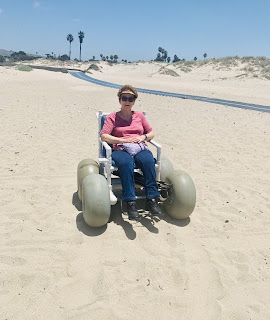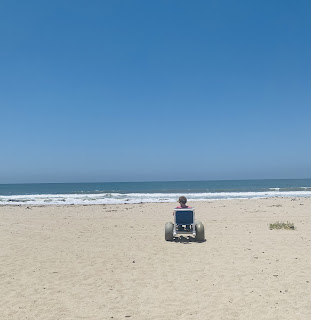I went to the beach this summer. I relaxed in the sand, just feet away from the water, watching children and adults and dogs having a wonderful time walking, playing, digging, relaxing, wading and swimming.
Occasionally, I would close my eyes, take a deep breath and drink in the soothing sounds of the waves.
That might not seem like a big deal to many, but it was to me. I’ve lived in Southern California for nearly 20 years and I hadn’t been that close to the surf since 2014.
Because I am disabled and have depended on a walker since 2005, sand is not my friend. “A day at the beach” does not connote ease or relaxation. For me, that phrase signifies frustration and a bit of mourning for what I am no longer able to do.
But this summer, I discovered beach wheelchairs.
Hallelujah!
With an asterisk.
Yay to their availability and affordability.
Boo to the fact that their existence is news to many, including the people who can use them and some staff at the beaches. And another boo to the cumbersome borrowing process and difficulty of getting into an accessible restroom from the monster truck version of a wheelchair.
A California girl, I cherished the proximity of the ocean and have many fond memories of days at the beach in northern, central and southern parts of the coast.
When I became disabled after my horrifying battle with cancer, I realized my limitations and resigned myself to enjoying the view from a car or sitting on a bench near the sand.
I learned on Facebook about Sabrina Cohen, a woman in Miami Beach who was working to make beaches accessible for the mobility-impaired. I commented, “We could use you in California.”
In 2014, I had my last close-to-the-surf excursion. I was determined to explore the possibilities of using my walker at the beach. My husband, who has helped steer me through non-Hodgkins lymphoma, a stem cell transplant and disability, packed in the car two of my walkers, foldable beach chairs and a blanket. When we got to Zuma Beach in Malibu, he guided me as I trekked unsteadily through the sand, lifting my walker step-by-step. I worried sand would somehow ruin my mobility aid. When I got to a midpoint in the sand, I transferred to a beach chair for a few minutes and then lay down flat on the blanket blissfully.
I don’t remember how I got up, but my husband must have put forth a Herculean effort. In the ensuing years, my muscles have weakened so that I often need assistance just getting up from a regular chair (from two people if possible). So I’ve scratched lying in the sand from my to-do list.
I did make a mental note when I saw an article somewhere that said a beach in Ventura had accessible wheelchairs available. I never investigated it further until this summer after learning relatives and their grandchildren were planning as visit and they wanted to go to a beach. A quick computer search led me to the San Buenaventura State Beach website which explained how to reserve a wheelchair free of charge over the phone.
We planned a trial run on a weekday when crowds would be minimal. The day before our excursion, I called the number listed on the site and left a message. When no one called back, I phoned later in the day. This time a lifeguard answered, said he couldn’t reserve one for me and I should call back the following morning. I called again the next day and again no one answered. I left a message saying we were on our way there (a 40 minute drive) and hopefully we would be able to borrow the chair.
We arrived there without knowing who to contact. While I waited in the car, my husband walked to a few administrative buildings before finding someone to help us. After a few more missteps, we got a larger-than-life beach wheelchair, which was one of four in a storage container, under lock and key.
I was able to sit in it fairly easily and my husband placed my portable fold-up walker on the rack below. Then he had to push me through the parking lot and paved trails to the boardwalk where we reached the sand - and about a 10-inch drop off. I was nervous about being tilted back in the chair and wary about going off the edge. My husband began kicking sand toward the edge of the threshold, trying to level the terrain. A woman out for a walk asked if she could help. No thanks, we said.
She continued her walk then came back to tell us there was a blue mat a bit further down the beach to facilitate the transition from wood to sand.
And voilà, there was. (It would have been nice if the lifeguards mentioned that when we checked out the chair.)
My husband pushed me down the trail to where the mat was and maneuvered me in the sand toward the shore. We took in the view and the sounds of the waves and had a relaxing, miniature hand-held picnic, my husband sitting on one of the enormous plastic wheels.

Notice the blue mat behind me
Before our trip back home, I needed to use an accessible restroom. My supersized wheelchair would not fit in the door.
Fortunately, my husband was able to grab my lightweight portable walker stored beneath the wheelchair and I was able to use that to get into the bathroom. Beachgoers who only use wheelchairs would need to be pushed to their parking space, swap the beach wheelchair for their personal wheelchair, travel back to the restroom and use the facilities, then repeat the process in reverse to get back in the beach wheelchair. (Which begs the question: what do you do with the giant beach device while you are using your wheelchair? Leave it unattended in the parking lot?)
Once we knew the basics of how to reserve a beach wheelchair and where to go on SanBuenaventura Beach, we were prepared for a return trip with our out-of-town guests. Again there was no answer when I tried to call ahead. This time we knew where to go for help and parked near where the blue mat was. Getting my chair and getting to the sand via the mat, was easier.
But our guests arrived before we did and asked a lifeguard where the blue mat was. His response: “We don’t do that anymore.”
Here is what I learned from dipping my toe into the world of accessible beach wheelchairs.
Who knew there are many beach wheelchairs available to borrow?
Certainly not me. When I became disabled nearly 16 years ago, nobody gave me a guidebook about how to live my new mobility-impaired life. It would have been nice to read though and see a mention of the availability of beach wheelchairs, instead of finding it out now. My research on the San Buenaventura State Beach website led to other helpful places where I learned they are available to borrow at many, many beaches. The California Coastal Commission lists 90 beaches in 15 counties where you can reserve a chair — a few have electric as well as manual. Los Angeles County publishes a Beach Wheelchair Information Sheet that shows 28 chairs are available at 16 beaches. While many of the state beaches require a reservation, none of the ones in LA County do. You must show an ID to borrow one and comply with any time limits imposed by the beach. Many of the wheelchairs are checked out and returned to a lifeguard, which the guides say may not be available due to other duties.
Using a beach wheelchair is not for introverts
You will attract a lot of attention. The wheelchair makes a lot of noise while it traverses parking lots or walkways. The oversized chair makes an over-the-top statement for its user: Yes, I’m disabled and I’m willing to use this somewhat wacky contraption so I can get on the sand! I’ve used a beach wheelchair twice for a total of about three hours and I got many smiles and stares and several questions. My husband was amused when a man asked him if he built it for me. My favorites were three state beach employees who I encountered near the accessible restroom. They acted amused and asked, “Where did you get that?” Here, we replied. They had no idea such a thing was available. One of them asked to take a picture of me in the chair. I said yes.
You will need an able-bodied, patient helper to help you manage the chair
It’s not easy to push a large awkward beach wheelchair. Or to make turns. Or to calm a newbie who might be apprehensive about being tilted back to get over bumps in the path. And your helper will have to do the running around, finding the right person to talk to and guard the beach wheelchair while you are in the restroom. I was able to sit in the chair fairly easily, with my hubby folding up my portable walker and storing it. But I can imagine it would not be easy to transfer to beach wheelchair from a regular wheelchair — the huge plastic wheels would get in the way. My friend who uses a wheelchair said she sat in a chair like the one I used at her daughter’s beach wedding in Hawaii 10 years ago. She doesn’t remember having trouble getting in it but she says she was stronger back then. Cory Lee, an experienced disability travel expert, offers this video to explain how he is lifted into the beach chair from his wheelchair in Florida. Not many wheelchair users have the help or equipment to accomplish this.
Do your homework before heading to a beach that offers wheelchairs
Some of the beach websites I’ve found give details like how many chairs are available, where the disabled parking is and whether the beach has mats to help get to the sand. Others just give a number to call. I would recommend that you give it a try like I did before arranging a beach outing, particularly one that involves other people. Because we figured out some of the kinks, my second visit went much better than the first. I wouldn’t want a mobility-challenged person to show up for an important gathering, only to find the chair won’t fit into the restroom or to learn they were the last of the first-come first-served wheelchair borrowers. And remember, not too many people know about the existence of the beach chairs. The local Ventura newspaper ran an article in May about the installation of a new mat at Harbor Cove Beach to allow people using chairs. The local Ventura newspaper ran an article in May about the installation of a new mat at Harbor Cove Beach to allow people using wheelchairs or pushing strollers an easier path to the water. The story says the mat will be pulled up in late fall and rolled out again in the spring. It calls the mat “the only one of its kind at a Ventura beach”.
Ummm. That is not correct. The mat where I used my beach wheelchair was at a Ventura beach 3 miles away.
So if you use a beach wheelchair and a mat to ease your path to the sand, or you see someone who does, spread the word. Not enough disabled beach-lovers know about them. And while finding and reserving a chair is a not always a smooth process, think of the payoff: A day at the beach.

Worth all the effort